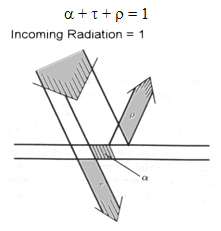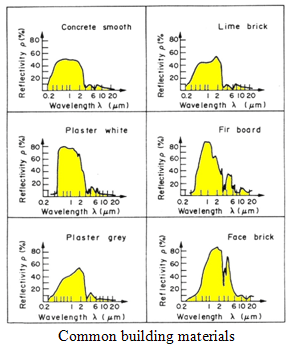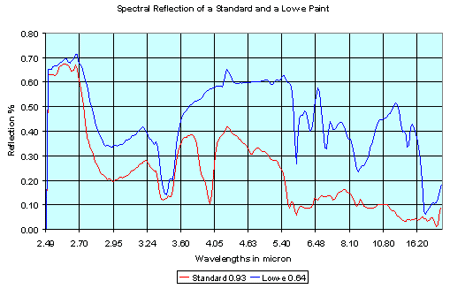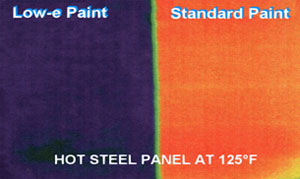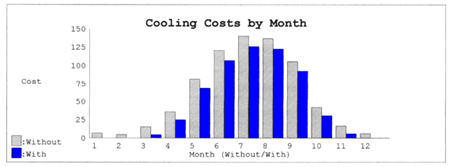Innovative Technologies for Energy Saving and Increase of Thermal Comfort
on energy savings and thermal comfort in hot climates
|
A short view on the physics of thermal radiation Thermal radiant heat transfer is usually associated with the rate at which energy is emitted by matter because of its finite temperature. All matter above absolute zero (0 Kelvin = -273°C = - 459.4°F) emits radiant energy in form of electromagnetic waves. The basic physical law concerning thermal radiation emission is the Stefan Boltzmann law, which states that that the heat flux emitted by an ideal radiator which is called a blackbody is proportional to the absolute temperature (Kelvin or Rankine) to the fourth power. The proportionality constant σ is called the stefan Boltzmann Constant.
The value of the Stefan Boltzmann Constant in USCS units is 0.1714 · 10-8; Btu/(h · ft² · °R4), and in SI units 5.67 · 10-8 W/(m² · K4). Real surfaces emit less radiation than the ideal blackbody. The ratio of actual emissive power Eb to the emissive power of a blackbody Eb at the same temperature is called the emissivity. It is defined by
Besides the emissivity there are three additional properties of surfaces which control the radiation heat transfer of a surface. The absorptivity α, transmissivity T and the reflectivity ρ. The sum of these properties has to be unity:
By knowing two properties of a surface the missing one can easily be calculated. Furthermore Kirchhoff’s identity rule states that absorbtivity and emissivity are equal at the same wavelength.
The heat flux emitted by an actual surface is then q = ε · σ T4 The standard situation Most common building materials have emissivity values ranging from 0.85 to 0.95. The only exceptions are low-e glass windows. Here the lower surface emissivity of the inner sides of the glass panes reduce the radiative heat transfer between the inner and outer pane. A room with low emissive inner surfaces has much in common with the low-e windows as far as the radiative heat exchange is concerned. The convective heat exchange is different though. It will be discussed in this paper what effects occur when the emissivity of indoor walls and ceilings are modified to lower emissivity values.
The above graphic shows the spectral reflectivity of different typical building materials. At the wavelengths of interest i.e. over 3 µm the reflectivity is very low and so the emissivity and absorbtion is very high, mostly over 90%. Which means these materials will absorb over 90% of the indoor generated heat radiation and lead it via heat conduction to the outside. For the summer climate when the sun heats up the outer walls, this means they will emit over 90% into the room. Standard wall paints have the same characteristics as far as the thermal infrared region of interest is concerned. The next diagram shows the reflectivity in the thermal infrared of a standard wall paint compared to a low-e wall paint.
Reflectivity of a standard wall paint compared to a low-e wall paint The new standard with low-e paints In hot climatic regions the temperature of the exterior walls of a building come close to air temperature as the change in outdoor temperature is not too big between night and day. At a temperature of the wall of 35° C for example, the resultant thermal radiation of a standard wall is 480 W/m². This heat cannot be simply vented away with a fan. It can be reduced only by increasing the cooling power of the air condition. In other words, the air condition has to compensate the heat radiation of the walls, so the air must be cooled down to an unpleasant degree. This is the only way persons in the room can release their metabolic heat. If the inside walls are painted with low-e wall paint, there will be a much more positive situation. In accordance with Max Planck’s law concerning the thermal radiation, the heat emitted from the walls can be reduced when compared with normally painted walls. The infrared image below shows a hot steel panel painted with a low-e paint on the left side. The color code of the camera, blue for cold and red to yellow for hot, shows that the standard painted side radiates much more heat.
Thermal image of a hot steel plate With an emissivity or e-value of 0.65 which is typical for Radiance the radiation of a wall at a temperature of 35°C will only be 330 W/m² instead of 480 W/m² with a standard paint. This means the air conditioning can be set to a higher temperature level and it does not have to run as often. Besides the savings in energy, which will be up to 20% for hot climatic regions, the thermal comfort in a building is improved remarkably. The following calculation shows the energy savings due to a low-e wall paint for a standard insulated house in a typical hot climatic region at New Orleans USA.
The annual cooling cost with a standard wall paint are at US$ 709 compared to
|


